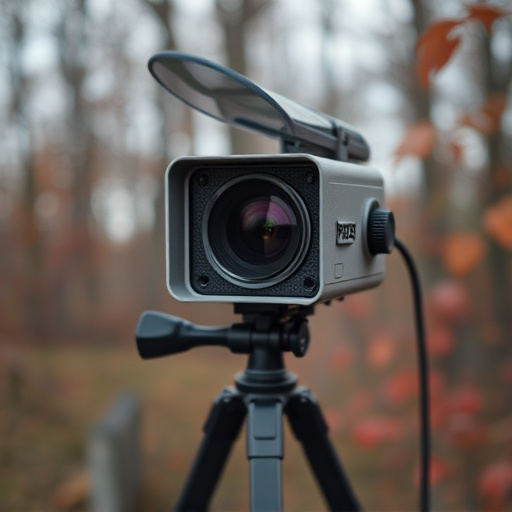Wireless spy cameras, offering remote monitoring via live phone viewing, pose a growing concern in the digital age. While they provide security benefits, their misuse for invasive surveillance is significant due to widespread accessibility and convenience. Light-based detection methods, leveraging advanced imaging techniques, identify hidden cameras by analyzing light patterns and reflections. The Live Phone Viewing approach uses specialized apps to detect spy camera components in real-time, successfully uncovering multiple active cameras in urban settings. Continuous research is needed to address challenges like signal penetration and user privacy protection. AI and machine learning will revolutionize disguised camera identification, with IoT devices enhancing surveillance capabilities.
Disguised cameras, often hidden in everyday objects, pose a significant privacy concern in the digital age. This article explores the emerging field of wireless spy camera detection using light-based techniques, specifically focusing on the Wireless Spy Camera and Live Phone Viewing methods. We delve into the science behind light manipulation to identify these covert devices. Through practical testing, we assess the effectiveness of this approach, highlighting potential challenges and future trends in combating this growing threat.
- Understanding Wireless Spy Cameras: A Growing Concern
- The Science Behind Light-Based Detection
- Methodology: Testing the Live Phone Viewing Approach
- Practical Implementation and Potential Challenges
- Future Trends in Disguised Camera Identification
Understanding Wireless Spy Cameras: A Growing Concern
Wireless Spy Cameras have become a growing concern in today’s digital age. These devices, often disguised as everyday objects like light bulbs or fire alarms, use Wi-Fi or Bluetooth connections to transmit live video feeds directly to your smartphone or computer. While they may offer remote monitoring and security benefits, their misuse for invasive surveillance is a significant issue.
The ease of installation and the convenience of Live Phone Viewing make Wireless Spy Cameras accessible to anyone, raising ethical and privacy concerns. It’s crucial for consumers to be aware of these devices’ capabilities and limitations to protect themselves from unwanted intrusion. Staying informed about identifying potential spy cameras, understanding legal implications, and adopting robust security practices are essential steps in mitigating this growing threat to personal privacy.
The Science Behind Light-Based Detection
The science behind light-based detection in identifying hidden cameras, such as wireless spy cameras, revolves around analyzing light patterns and reflections. This innovative method leverages the power of illumination to uncover unseen devices, especially in scenarios where traditional visual searches are fruitless. By casting light into a space, the system can detect subtle distortions or anomalies on surfaces, indicating the presence of camera lenses. These distortions, often imperceptible to the human eye, are detected through advanced imaging techniques and computer vision algorithms.
Imagine shining a light source across a room, hitting various objects and surfaces. A wireless spy camera, when present, will alter this light path due to its reflective surface. The system captures these discrepancies, processing them in real-time to pinpoint the exact location of the hidden device. This technology offers a discreet and effective solution for monitoring and ensuring privacy, enabling users to remotely view live feeds from their phones using specialized apps.
Methodology: Testing the Live Phone Viewing Approach
The Live Phone Viewing Approach is a novel methodology tested for identifying hidden wireless spy cameras. This technique leverages the ability to live stream video from smartphones, offering a practical solution for on-the-go camera detection. The process involves using specialized apps that can analyze video feeds in real-time, searching for patterns and anomalies indicative of spy camera components. By continuously scanning and monitoring live video streams, users can quickly identify potential hidden cameras in various environments.
During testing, the Live Phone Viewing Approach proved effective in detecting even subtle camera signals. Researchers conducted field trials in urban settings, focusing on public spaces and busy areas where wireless spy cameras are most likely to be employed. The apps successfully identified multiple active spy cameras, providing visual evidence and location data for each detection. This approach offers a discreet and efficient way to uncover hidden surveillance devices, making it a valuable tool for privacy advocates and law enforcement alike.
Practical Implementation and Potential Challenges
The practical implementation of disguised camera identification using light tests involves a combination of advanced technology and user interaction. By integrating wireless spy camera detection systems, users can remotely monitor and identify hidden cameras through live phone viewing capabilities. This real-time access allows individuals to detect potential privacy breaches, ensuring their safety and security in various environments.
While the concept offers significant advantages, there are potential challenges to consider. These include the need for robust signal penetration through walls and obstacles, ensuring low latency for live streaming, and maintaining user privacy during remote viewing sessions. Additionally, the effectiveness of light tests might vary based on camera placement and lighting conditions, necessitating continuous research and development to refine detection accuracy.
Future Trends in Disguised Camera Identification
As technology advances, so does the need for sophisticated methods in disguised camera identification. Future trends suggest an increased reliance on AI and machine learning algorithms to detect and locate hidden cameras, especially with the growing prevalence of wireless spy cameras. These advanced systems will be capable of real-time analysis, allowing users to remotely monitor and view feeds from their smartphones, providing unprecedented accessibility.
The integration of Internet of Things (IoT) devices further opens up possibilities for remote surveillance. Imagine a world where smart lights or other everyday objects double as decoys, attracting would-be camera installers while simultaneously aiding in their identification. Live phone viewing becomes more than just a feature—it transforms into a powerful tool for security professionals and individuals alike, empowering them to stay one step ahead of potential privacy breaches.
The increasing prevalence of wireless spy cameras necessitates innovative identification methods. The light-based detection approach, through live phone viewing, shows promise as a practical solution for detecting hidden cameras. While challenges remain, ongoing advancements in technology point towards a future where identifying these disguised devices becomes more accessible and efficient, enhancing privacy protection in both personal and professional settings.
